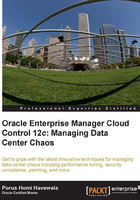
The Grid – where the cloud came from
In 2003, Oracle Database 10g was released—where the "g" stood for Grid.
Oracle had previously released Real Application Clusters (RAC) in Oracle 9i, which was the first active/active database system (multiple nodes and instances accessing the same database).
This technology made it possible to cluster large numbers of smaller servers and place the application's database on the cluster as a whole. So, instead of placing the database on a larger and dedicated expensive server that had been sized suitably to accommodate the changes for the next two years of application life, it could be placed on a cluster of smaller servers, sized appropriately.
As the application's demand increased, it would be easy to just add an extra node to the database cluster and expand horizontally instead of vertically. The database services (applications) could also share any of the nodes in the cluster instead of having a dedicated server installed for each application. This intention to replace dedicated servers and expensive hardware from specialized vendors was the genesis of the Grid idea.
RAC technology was considerably enhanced in the 10g version. Oracle Clusterware software was now available in 10g for most platforms, thus negating the need for other clustering software. For example, using RAC 10g on SUN Solaris no longer meant having to preinstall the SUN Cluster, which was the case in RAC 9i for this platform.
It was now possible to have a Grid based on almost any platform where smaller servers could be clustered together with the clustering software from Oracle. This was applicable to the application servers as well, at that time using Oracle Application Server (please note, the current preferred cluster of application servers is Oracle WebLogic Server 12c Enterprise Edition).
Therefore, the versions of Oracle Database and Application Server from then on were named 10g and later 11g, emphasizing the importance Oracle was placing on the Grid.
For the management side of things, Oracle Enterprise Manager 10g and consequently 11g were released on an N-tier architecture. The powerful enterprise management product was named as Grid Control, due to its ability to manage the Grid based on Oracle Clustering technology. Multiple databases and application servers could be managed.
Provisioning capabilities were introduced from Enterprise Manager Grid Control 10g onwards, and this allowed the DBA to create gold copies of Oracle software and databases in a Software Library in Enterprise Manager, and then use the gold copy when seeking to provision the software or databases on new servers. Thus, provisioning of the Grid was now possible via an automated means. This helped with on-demand elasticity, or the ability to grow or shrink the Grid.
The Grid, as conceptualized by Oracle, was thus in place for a number of years. Then, a few years ago the idea of Cloud computing exploded on the IT scene. It seemed that almost every other hardware and software vendor was pushing Cloud computing.
But if you take a closer look, what is the Cloud? The National Institute of Standards (NIST) defines Cloud Computing as essentially being:
On-demand Access to a Shared Pool of Computing Resources.
This is actually what the Grid is about. So how different is the Cloud to the Grid?
The Cloud as such is a superset of the Grid—but with a few more characteristics, such as self service by the user, metering, and chargeback.
The five essential characteristics of Cloud computing are defined as on-demand self-service, pooling of resources, elasticity (able to expand or scale down on notice), measured service (that is, metering of usage), and broad network access.
Oracle already had a deep technological foundation in the Grid, with technologies such as RAC Clustering, WebLogic Server Clustering, and Enterprise Manager management of the cluster with provisioning capabilities. Now, self-service, metering, and chargeback were added in Oracle Enterprise Manager on top of the Grid capabilities.
As a result, Oracle is now fully Cloud-capable. And its Enterprise Manager Cloud Control 12c is the management backbone of the entire Cloud.